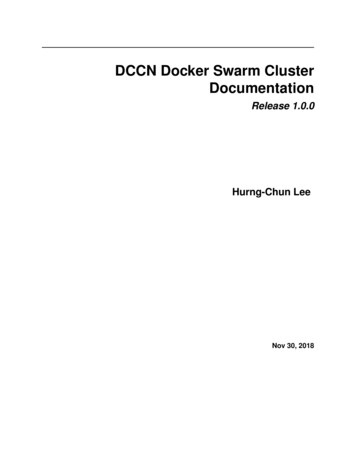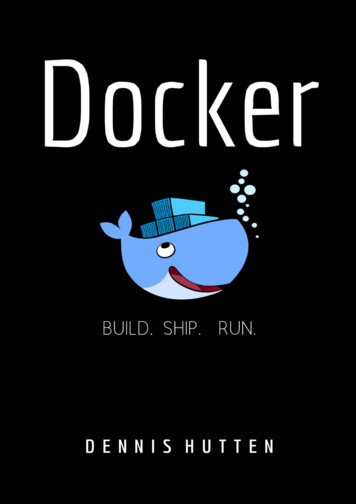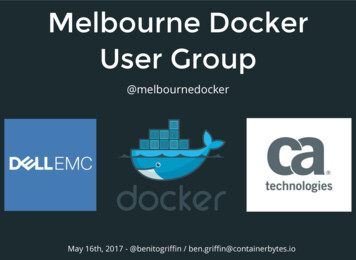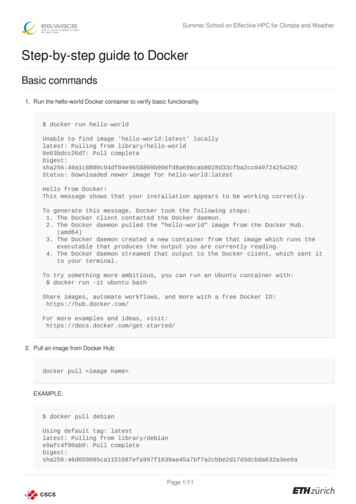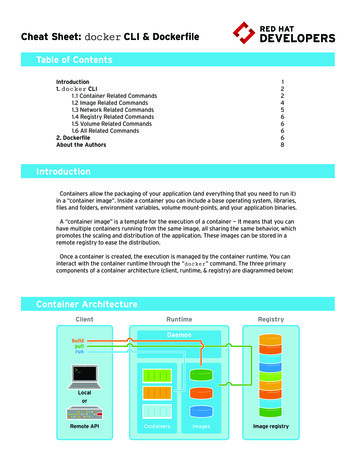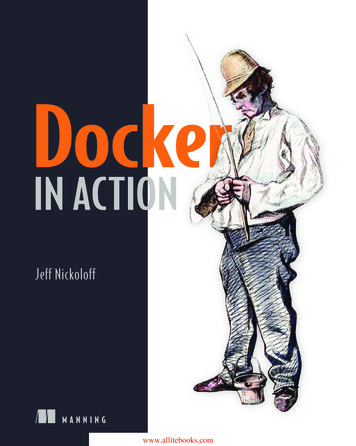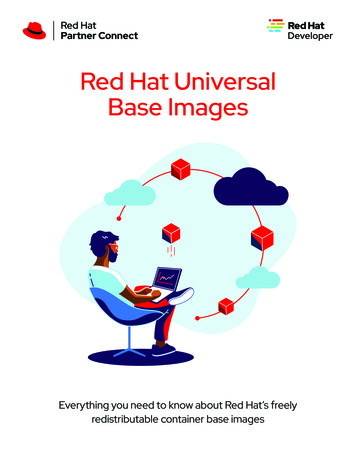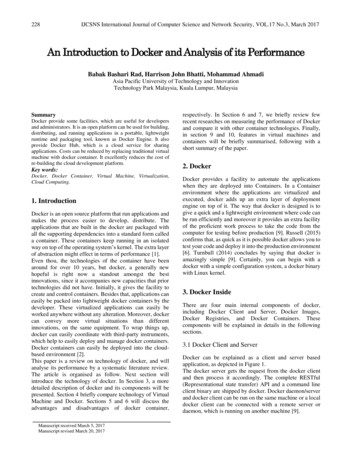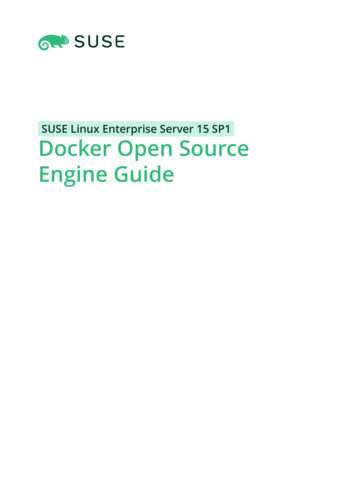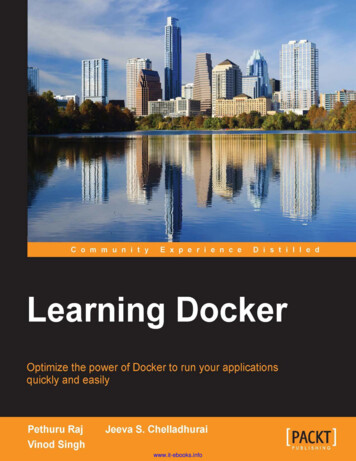
Transcription
[1]www.it-ebooks.info
Learning DockerOptimize the power of Docker to run your applicationsquickly and easilyPethuru RajJeeva S. ChelladhuraiVinod SinghBIRMINGHAM - MUMBAIwww.it-ebooks.info
Learning DockerCopyright 2015 Packt PublishingAll rights reserved. No part of this book may be reproduced, stored in a retrievalsystem, or transmitted in any form or by any means, without the prior writtenpermission of the publisher, except in the case of brief quotations embedded incritical articles or reviews.Every effort has been made in the preparation of this book to ensure the accuracyof the information presented. However, the information contained in this book issold without warranty, either express or implied. Neither the authors, nor PacktPublishing, and its dealers and distributors will be held liable for any damagescaused or alleged to be caused directly or indirectly by this book.Packt Publishing has endeavored to provide trademark information about all of thecompanies and products mentioned in this book by the appropriate use of capitals.However, Packt Publishing cannot guarantee the accuracy of this information.First published: June 2015Production reference: 1240615Published by Packt Publishing Ltd.Livery Place35 Livery StreetBirmingham B3 2PB, UK.ISBN o
CreditsAuthorsCopy EditorsPethuru RajVikrant PhadkeJeeva S. ChelladhuraiRashmi SawantVinod SinghTrishla SinghReviewersProject CoordinatorShashikant BangeraNidhi JoshiSergei VizelProofreaderBaohua YangSafis EditingCommissioning EditorSarah CroftonHemangini BariAcquisition EditorGraphicsLarissa PintoSheetal AuteContent Development EditorKirti PatilProduction CoordinatorNitesh ThakurTechnical EditorsDhiraj ChandanshiveNarsimha PaiIndexerCover WorkNitesh Thakurwww.it-ebooks.info
About the AuthorsPethuru Raj, PhD, works as a cloud architect at the IBM Global Cloud Center ofExcellence (CoE) in Bangalore, India. He completed his CSIR-sponsored PhD degreeat Anna University, Chennai, and continued his UGC-sponsored postdoctoralresearch at the Department of Computer Science and Automation of IISc, Bangalore.Thereafter, he was granted a couple of international research fellowships (JSPS andJST) to work as a research scientist for 3 years at two leading Japanese universities.Pethuru has contributed to a number of high-quality technology books that areedited by internationally acclaimed professionals. In association with another IBMer,he has recently submitted the complete manuscript for a book called Smart Cities: theEnabling Technologies and Tools, to be published by the CRC Press in the USA in May2015. He has collaborated with a few established authors to publish a book calledHigh-Performance Big Data Analytics, which will be published by Springer-Verlag,UK, in 2015. He maintains an IT portal at http://www.peterindia.net, and hisLinkedIn profile can be found at https://www.linkedin.com/in/peterindia.Jeeva S. Chelladhurai has been working as a technical project manager at theIBM Global Cloud Center of Excellence (CoE) in India for the last 8 years. He hasmore than 18 years of experience in the IT industry. In various capacities, he hastechnically managed and mentored diverse teams across the globe in envisaging andbuilding pioneering telecommunication products. He specializes in cloud solutiondelivery, with a focus on data center optimization, software-defined environments(SDEs), and distributed application development, deployment, and deliveryusing the newest Docker technology. Jeeva is also a strong proponent of Agilemethodologies, DevOps, and IT automation. He holds a master's degree in computerscience from Manonmaniam Sundaranar University and a graduation certificate inproject management from Boston University. He has been instrumental in craftingreusable assets for IBM solution architects and consultants in Docker-inspiredcontainerization technology.www.it-ebooks.info
Vinod Singh is a lead architect for IBM's cloud computing offerings. He hasmore than 18 years of experience in the cloud computing, networking, and datacommunication domains. Currently, he works for IBM's cloud application servicesand partner marketplace offerings. Vinod has worked on architecting, deploying,and running IBM's PaaS offering (BlueMix) on the SoftLayer infrastructure cloud.He also provides consultancy and advisory services to clients across the globe onthe adoption of cloud technologies. He is currently focusing on various applicationsand services on the IBM Marketplace/BlueMix/SoftLayer platform. He is a graduateengineer from the National Institute of Technology, Jaipur, and completed hismaster's degree at BITS, Pilani.www.it-ebooks.info
About the ReviewersShashikant Bangera is a DevOps architect with 16 years of IT experience.He has vast exposure to DevOps tools across the platform, with core expertise inopen source. He has helped his customers adopt DevOps practice and implementedEnterprise DevOps for them and has also contributed to many open sourcesplatforms, such as DevOps Publication. He has designed an automated on-demandenvironment with a set of open source tools and also an environment booking tool,which is available on GitHuB. His Twitter handle is @shzshi.Sergei Vizel is a senior software engineer at Modera (modera.org). He is afull-stack web application developer with more than 10 years of impressiveexperience. He is a firm believer of the value and power of open source softwareand contributes to projects on GitHub. Sergei has published numerous pieces ofopen source code of his own. You can learn more about him and contact him onGitHub via https://github.com/cravler.www.it-ebooks.info
Baohua Yang is a research scientist on cloud-computing-related technologies atIBM. He is a contributor to many open source communities such as OpenStack,OpenvSwitch, Docker, and OpenDaylight. He is also a TPC member and a reviewerof a number of international conferences and journals.Baohua's interests mainly include system and application architecture, performanceoptimization, and security issues in cloud networking and distributed systems,especially in emerging technologies such as cloud computing, SDN, and NFV.He has written many technical books and articles to introduce and analyzethese techniques. He loves open source technologies and enjoys designing andimplementing efficient systems with elegant architecture.www.it-ebooks.info
www.PacktPub.comSupport files, eBooks, discount offers, and moreFor support files and downloads related to your book, please visitwww.PacktPub.com.Did you know that Packt offers eBook versions of every book published, with PDFand ePub files available? You can upgrade to the eBook version at www.PacktPub.comand as a print book customer, you are entitled to a discount on the eBook copy. Get intouch with us at service@packtpub.com for more details.At www.PacktPub.com, you can also read a collection of free technical articles,sign up for a range of free newsletters and receive exclusive discounts and offers onPackt books and ion/packtlibDo you need instant solutions to your IT questions? PacktLib is Packt's online digitalbook library. Here, you can search, access, and read Packt's entire library of books.Why subscribe? Fully searchable across every book published by PacktCopy and paste, print, and bookmark contentOn demand and accessible via a web browserFree access for Packt account holdersIf you have an account with Packt at www.PacktPub.com, you can use this to accessPacktLib today and view 9 entirely free books. Simply use your login credentials forimmediate access.www.it-ebooks.info
Table of ContentsPrefaceChapter 1: Getting Started with Dockervii1Chapter 2: Handling Docker Containers17An introduction to DockerDocker on LinuxDifferentiating between containerization and virtualizationThe convergence of containerization and virtualizationContainerization technologiesInstalling the Docker engineInstalling from the Ubuntu package repositoryInstalling the latest Docker using docker.io scriptUnderstanding the Docker setupClient server communicationDownloading the first Docker imageRunning the first Docker containerRunning a Docker container on Amazon Web ServicesTroubleshootingSummaryClarifying the Docker termsDocker images and containersA Docker layerA Docker containerDocker RegistryDocker 15181820202021
Table of ContentsWorking with Docker imagesDocker Hub RegistrySearching Docker imagesWorking with an interactive containerTracking changes inside containersControlling Docker containersHousekeeping containersBuilding images from containersLaunching a container as a daemonSummary21232426283034353738Chapter 3: Building Images39Chapter 4: Publishing Images59Docker's integrated image building systemA quick overview of the Dockerfile's syntaxThe Dockerfile build instructionsThe FROM instructionThe MAINTAINER instructionThe COPY instructionThe ADD instructionThe ENV instructionThe USER instructionThe WORKDIR instructionThe VOLUME instructionThe EXPOSE instructionThe RUN instructionThe CMD instructionThe ENTRYPOINT instructionThe ONBUILD instructionThe .dockerignore fileA brief overview of the Docker image managementBest practices for writing DockerfilesSummaryUnderstanding the Docker HubPushing images to the Docker HubAutomating the building process for imagesPrivate repositories on the Docker HubOrganizations and teams on the Docker HubThe REST APIs for the Docker HubSummary[ ii 55556585860636871727375
Table of ContentsChapter 5: Running Your Private Docker InfrastructureThe Docker registry and indexDocker registry use casesRun your own index and registryStep 1 – Deployment of the index components andthe registry from GitHubStep 2 – Configuration of nginx with the Docker registryStep 3 – Set up SSL on the web server for secure communicationPush the image to the newly created Docker registrySummaryChapter 6: Running Services in a ContainerA brief overview of container networkingEnvisaging the Container as a ServiceBuilding an HTTP server imageRunning the HTTP server Image as a ServiceConnecting to the HTTP serviceExposing container servicesPublishing container ports – the -p optionNetwork Address Translation for containersRetrieving the container portBinding a container to a specific IP addressAuto-generating the Docker host portPort binding using EXPOSE and the -P optionSummaryChapter 7: Sharing Data with ContainersThe data volumeSharing host dataThe practicality of host data sharingSharing data between containersData-only containersMounting data volume from other containersThe practicality of data sharing between containersAvoiding common pitfallsDirectory leaksThe undesirable effect of data volumeSummary[ iii 126128
Table of ContentsChapter 8: Orchestrating Containers129Chapter 9: Testing with Docker151Chapter 10: Debugging Containers175Chapter 11: Securing Docker Containers191Linking containersOrchestration of containersOrchestrate containers using docker-composeInstalling docker-composeThe docker-compose.yml fileThe docker-compose commandCommon usageSummaryA brief overview of the test-driven developmentTesting your code inside DockerRunning the test inside a containerUsing a Docker container as a runtime environmentIntegrating Docker testing into JenkinsPreparing the Jenkins environmentAutomating the Docker testing processSummaryProcess level isolation for Docker containersControl groupsDebugging a containerized applicationThe Docker exec commandThe Docker ps commandThe Docker top commandThe Docker stats commandThe Docker events commandThe Docker logs commandInstalling and using nsenterSummaryAre Docker containers secure enough?The security facets – virtual machines versus Docker containersThe security features of containersResource isolationResource accounting and control[ iv 192192194195196
Table of ContentsThe root privilege – impacts and best practices197Security-Enhanced Linux for container securitySELinux-inspired benefitsThe best practices for container securityDigital signature verificationSecure deployment guidelines for DockerThe futureSummary199201203206207208209The trusted user controlNon-root containersLoading the Docker images and the security implicationsThe emerging security 1
www.it-ebooks.info
PrefaceWe have been fiddling with virtualization techniques and tools for quite a long timenow in order to establish the much-demanded software portability. The inhibitingdependency factor between software and hardware needs to be decimated byleveraging virtualization, a kind of beneficial abstraction, through an additional layerof indirection. The idea is to run any software on any hardware. This is achievedby creating multiple virtual machines (VMs) out of a single physical server, witheach VM having its own operating system (OS). Through this isolation, which isenacted through automated tools and controlled resource sharing, heterogeneousapplications are accommodated in a physical machine.With virtualization, IT infrastructures become open, programmable, remotelymonitorable, manageable, and maintainable. Business workloads can be hosted inappropriately-sized virtual machines and delivered to the outside world, ensuringbroader and more frequent utilization. On the other hand, for high-performanceapplications, virtual machines across multiple physical machines can be readilyidentified and rapidly combined to guarantee any kind of high-performancerequirement.The virtualization paradigm has its own drawbacks. Because of the verbosity andbloatedness (every VM carries its own operating system), VM provisioning typicallytakes a while, the performance goes down due to excessive usage of computationalresources, and so on. Furthermore, the growing need for portability is not fully metby virtualization. Hypervisor software from different vendors comes in the way ofensuring application portability. Differences in the OS and application distributions,versions, editions, and patches hinder smooth portability. Computer virtualizationhas flourished, whereas the other, closely associated concepts of network and storagevirtualization are just taking off. Building distributed applications through VMinteractions invites and involves some practical difficulties.[ vii ]www.it-ebooks.info
PrefaceLet's move on to containerization. All of these barriers contribute to theunprecedented success of the idea of containerization. A container generally containsan application, and all of the application's libraries, binaries, and other dependenciesare stuffed together to be presented as a comprehensive, yet compact, entity forthe outside world. Containers are exceptionally lightweight, highly portable, easilyand quickly provisionable, and so on. Docker containers achieve native systemperformance. The greatly articulated DevOps goal gets fully fulfilled throughapplication containers. As best practice, it is recommended that every container hostsone application or service.The popular Docker containerization platform has come up with an enablingengine to simplify and accelerate the life cycle management of containers. There areindustry-strength and openly automated tools made freely available to facilitate theneeds of container networking and orchestration. Therefore , producing and sustainingbusiness-critical distributed applications is becoming easy. Business workloads aremethodically containerized to be easily taken to cloud environments, and they areexposed for container crafters and composers to bring forth cloud-based softwaresolutions and services. Precisely speaking, containers are turning out to be the mostfeatured, favored, and fine-tuned runtime environment for IT and business services.This book is meticulously designed and developed in order to empower developers,cloud architects, business managers, and strategists with all the right and relevantinformation on the Docker platform and its capacity to power up mission-critical,composite, and distributed applications across industry verticals.What this book coversChapter 1, Getting Started with Docker, talks about the Docker platform andhow it simplifies and speeds up the process of realizing containerized workloads tobe readily deployed and run on a variety of platforms. This chapter also has stepby-step details on installing the Docker engine, downloading a Docker image fromthe centralized Docker Hub, creating a Docker container out of that image, andtroubleshooting the Docker container.Chapter 2, Handling Docker Containers, is primarily meant to expound the commandsrequired to manage Docker images and containers. This chapter provides the basicDocker terminologies needed to understand the output of Docker commands.Other details covered here include starting an interactive session inside a container,managing your images, running containers, and tracking changes inside containers.Chapter 3, Building Images, introduces Docker's integrated image building system.The other important topics covered in this chapter include a quick overview of aDockerfile's syntax and a bit of theory on how Docker stores images.[ viii ]www.it-ebooks.info
PrefaceChapter 4, Publishing Images, focuses on publishing images on the centralized DockerHub and how to get the most out of the Docker Hub. The other important contentsin the chapter include greater details about the Docker Hub, how to push images tothe Docker Hub, the automatic building of images, creating organizations on DockerHub, and finally private repositories.Chapter 5, Running Your Private Docker Infrastructure, explains how corporates canset up their own private repositories. Due to certain reasons, corporates may notwant to host specific Docker images in publicly-available image repositories, suchas the Docker Hub. Here, the need for their own private repository to keep up thoseimages arises. This chapter has all of the information required to set up and sustainprivate repositories.Chapter 6, Running Services in a Container, illustrates how a web application can berun inside a Docker container as a service, and how to expose the service for theoutside world to find and access it. How the appropriate Dockerfile gets developedto simplify this task is also described in detail.Chapter 7, Sharing Data with Containers, shows you how to use Docker's volumesfeature to share data between the Docker host and its containers. The other topicscovered here are how to share data between containers, the common use cases, andthe typical pitfalls to avoid.Chapter 8, Orchestrating Containers, focuses on orchestrating multiplecontainers towards composite, containerized workloads. It is a well-knowntruth that orchestration plays a major role in producing composite applications.This chapter includes some information about orchestration and the toolset madeavailable for enabling the process of orchestration. Finally, you will find a wellorchestrated example of how containers can be orchestrated to bring forth highlyreusable and business-aware containers.Chapter 9, Testing with Docker, focuses on testing your code inside Docker images.In this chapter, you find out how to run the tests inside an ad hoc Docker image.Finally, you come across details of how to integrate Docker testing into a continuousintegration server, such as Jenkins.Chapter 10, Debugging Containers, teaches you how to debug applications runninginside containers. Also, the details regarding how Docker ensures that processesrunning inside containers are isolated from the outside world are covered.Furthermore, descriptions of the usage of the nsenter and nsinit tools for effectivedebugging are included.[ ix ]www.it-ebooks.info
PrefaceChapter 11, Securing Docker Containers, is crafted to explain the brewing securityand privacy challenges and concerns, and how they are addressed through theliberal usage of competent standards, technologies, and tools. This chapter inscribesthe mechanism on dropping user privileges inside an image. There is also a briefintroduction on how the security capabilities introduced in SELinux come in handywhen securing Docker containers.What you need for this bookThe Docker platform requires a 64-bit hardware system to run on. Dockerapplications have been developed on Ubuntu 14.04 for this book, but this doesnot mean that the Docker platform cannot run on other Linux distributions,such as Redhat, CentOS, CoreOS, and so on. However, the Linux kernel versionmust be 3.10 or above.Who this book is forIf you are an application developer who wants to learn about Docker in order toutilize its features for application deployment, then this book is for you. No priorknowledge of Docker is required.ConventionsIn this book, you will find a number of text styles that distinguish between differentkinds of information. Here are some examples of these styles and an explanation oftheir meaning.Code words in text, database table names, folder names, filenames, file extensions,pathnames, dummy URLs, user input, and Twitter handles are shown as follows:"If the docker service is running, then this command will print the status asstart/running, along with its process ID."A block of code is set as follows:FROM busybox:latestCMD echo Hello World!![x]www.it-ebooks.info
PrefaceAny command-line input or output is written as follows: sudo docker tag 224affbf9a65 localhost:5000/vinoddandy/dockerfileimageforhubNew terms and important words are shown in bold. Words that you see on thescreen, for example, in menus or dialog boxes, appear in the text like this: "Select theDocker option, which is in the drop-down menu, and then click on Launch Now."Warnings or important notes appear in a box like this.Tips and tricks appear like this.Reader feedbackFeedback from our readers is always welcome. Let us know what you think aboutthis book—what you liked or disliked. Reader feedback is important for us as it helpsus develop titles that you will really get the most out of.To send us general feedback, simply e-mail feedback@packtpub.com, and mentionthe book's title in the subject of your message.If there is a topic that you have expertise in and you are interested in either writingor contributing to a book, see our author guide at www.packtpub.com/authors.Customer supportNow that you are the proud owner of a Packt book, we have a number of things tohelp you to get the most from your purchase.Downloading the example codeYou can download the example code files from your account at http://www.packtpub.com for all the Packt Publishing books you have purchased. If youpurchased this book elsewhere, you can visit http://www.packtpub.com/supportand register to have the files e-mailed directly to you.[ xi ]www.it-ebooks.info
ErrataAlthough we have taken every care to ensure the accuracy of our content, mistakesdo happen. If you find a mistake in one of our books—maybe a mistake in the text orthe code—we would be grateful if you could report this to us. By doing so, you cansave other readers from frustration and help us improve subsequent versions of thisbook. If you find any errata, please report them by visiting http://www.packtpub.com/submit-errata, selecting your book, clicking on the Errata Submission Formlink, and entering the details of your errata. Once your errata are verified, yoursubmission will be accepted and the errata will be uploaded to our website or addedto any list of existing errata under the Errata section of that title.To view the previously submitted errata, go to https://www.packtpub.com/books/content/support and enter the name of the book in the search field. The requiredinformation will appear under the Errata section.PiracyPiracy of copyrighted material on the Internet is an ongoing problem across allmedia. At Packt, we take the protection of our copyright and licenses very seriously.If you come across any illegal copies of our works in any form on the Internet, pleaseprovide us with the location address or website name immediately so that we canpursue a remedy.Please contact us at copyright@packtpub.com with a link to the suspectedpirated material.We appreciate your help in protecting our authors and our ability to bring youvaluable content.QuestionsIf you have a problem with any aspect of this book, you can contact us atquestions@packtpub.com, and we will do our best to address the problem.www.it-ebooks.info
Getting Started with DockerThese days, Docker technology is gaining more market and more mind sharesamong information technology (IT) professionals across the globe. In this chapter,we would like to shed more light on Docker, and show why it is being touted asthe next best thing for the impending cloud IT era. In order to make this bookrelevant to software engineers, we have listed the steps needed for crafting highlyusable application-aware containers, registering them in a public registry repository,and then deploying them in multiple IT environments (on-premises as well asoff-premises). In this book, we have clearly explained the prerequisites and the mostimportant details of Docker, with the help of all the education and experiences thatwe could gain through a series of careful implementations of several useful Dockercontainers in different systems. For doing this, we used our own laptops as well as afew leading public Cloud Service Providers (CSP).We would like to introduce you to the practical side of Docker for the gamechanging Docker-inspired containerization movement.In this chapter, we will cover the following topics: An introduction to Docker Docker on Linux Differentiating between containerization and virtualization Installing the Docker engine Understanding the Docker setup Downloading the first image Running the first container Running a Docker container on Amazon Web Services (AWS) Troubleshooting the Docker containers[1]www.it-ebooks.info
Getting Started with DockerAn introduction to DockerDue to its overwhelming usage across industry verticals, the IT domain has beenstuffed with many new and pathbreaking technologies used not only for bringingin more decisive automation but also for overcoming existing complexities.Virtualization has set the goal of bringing forth IT infrastructure optimization andportability. However, virtualization technology has serious drawbacks, such asperformance degradation due to the heavyweight nature of virtual machines (VM),the lack of application portability, slowness in provisioning of IT resources, and soon. Therefore, the IT industry has been steadily embarking on a Docker-inspiredcontainerization journey. The Docker initiative has been specifically designed formaking the containerization paradigm easier to grasp and use. Docker enables thecontainerization process to be accomplished in a risk-free and accelerated fashion.Precisely speaking, Docker is an open source containerization engine, whichautomates the packaging, shipping, and deployment of any software applicationsthat are presented as lightweight, portable, and self-sufficient containers, that willrun virtually anywhere.A Docker container is a software bucket comprising everything necessary to runthe software independently. There can be multiple Docker containers in a singlemachine and containers are completely isolated from one another as well as fromthe host machine.In other words, a Docker container includes a software component along withall of its dependencies (binaries, libraries, configuration files, scripts, jars, and soon). Therefore, the Docker containers could be fluently run on x64 Linux kernelsupporting namespaces, control groups, and file systems, such as Another UnionFile System (AUFS). However, as indicated in this chapter, there are pragmaticworkarounds for running Docker on other mainstream operating systems, suchas Windows, Mac, and so on. The Docker container has its own process space andnetwork interface. It can also run things as root, and have its own /sbin/init,which can be different from the host machines'.In a nutshell, the Docker solution lets us quickly assemble composite, enterprisescale, and business-critical applications. For doing this, we can use different anddistributed software components: Containers eliminate the friction that comes withshipping code to distant locations. Docker also lets us test the code and then deployit in production as fast as possible. The Docker solution primarily consists of thefollowing components: The Docker engine The Docker Hub[2]www.it-ebooks.info
Chapter 1The Docker engine is for enabling the realization of purpose-specific as well asgeneric Docker containers. The Docker Hub is a fast-growing repository of theDocker images that can be combined in different ways for producing publiclyfindable, network-accessible, and widely usable containers.Docker on LinuxSuppose that we want to directly run the containers on a Linux machine. The Dockerengine produces, monitors, and manages multiple containers as illustrated in thefollowing diagram:The preceding diagram vividly illustrates how future IT systems would havehundreds of application-aware containers, which would innately be capable offacilitating their seamless integration and orchestration for deriving modularapplications (business, social, mobile, analytical, and embedded solutions). Thesecontained applications could fluently run on converged, federated, virtualized,shared, dedicated, and automated infrastructures.[3]www.it-ebooks.info
Getting Started with DockerDifferentiating between containerizationand virtualizationIt is pertinent, and paramount to extract and expound the ga
An introduction to Docker 2 Docker on Linux 3 Differentiating between containerization and virtualization 4 The convergence of containerization and virtualization 5 Containerization technologies 6 Installing the Docker engine 7 Installing from the Ubuntu package repository 7 Installing the latest Docker using docker.io script 8

